Game for a personal asteroid flyby? Break out your binoculars or telescope for a peek at the bright asteroids Pallas and Iris, both at opposition this spring.
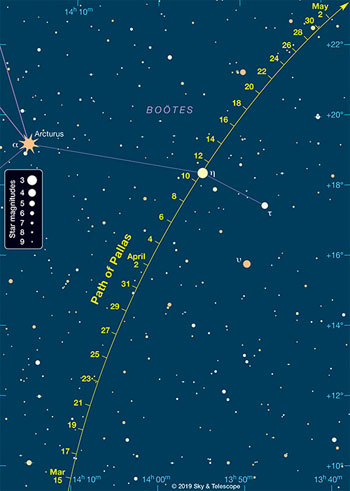
Asteroids are hot. New photos and findings are posted almost weekly from the Japanese Hayabusa 2 probe at Ryugu and NASA's Osiris-REX mission at Bennu. There's nothing like getting up close for an in-situ view. But while we can't all be like the Little Prince, who lived on his own personal Bennu, we can participate in the current renaissance of small body studies by tracking two bright asteroids this spring — 2 Pallas and 7 Iris.
Pallas, the second asteroid discovered after Ceres, was found by German astronomer Heinrich Olbers (of Olbers Paradox fame) on March 28, 1802. During the early 19th century, Pallas and its ken were called planets, but as more and more of the starlike objects were discovered, astronomers came to realize they belonged to a class all their own.
What to call them? Many names were suggested including stellula, planetkin, planeret, planetling, but in the end, William Herschel proposed the term asteroid from the Greek for "starlike." Herschel didn't coin the word. That honor goes to the young Greek scholar Charles Burney Jr. He suggested it to his father, who passed it along to Herschel.
After Ceres and Vesta, Pallas is the third most massive asteroid with a diameter of 512 km. No rubble pile like Bennu and Ryugu, it appears to be a protoplanet, a planetary embryo large enough to have undergone internal melting into a differentiated body.
Pallas reaches opposition on April 6th at magnitude 7.9 just 5° southwest of Arcturus in Boötes. During the coming week it stands about 25° at 10 p.m. local time and should be visible with a pair of 50-mm binoculars from reasonably dark skies. For easier viewing without the shakes, use a small telescope. Although similar in size to Vesta, Pallas is much darker — its surface reflects just 12% of the light it receives from the Sun compared to 40% for Vesta.
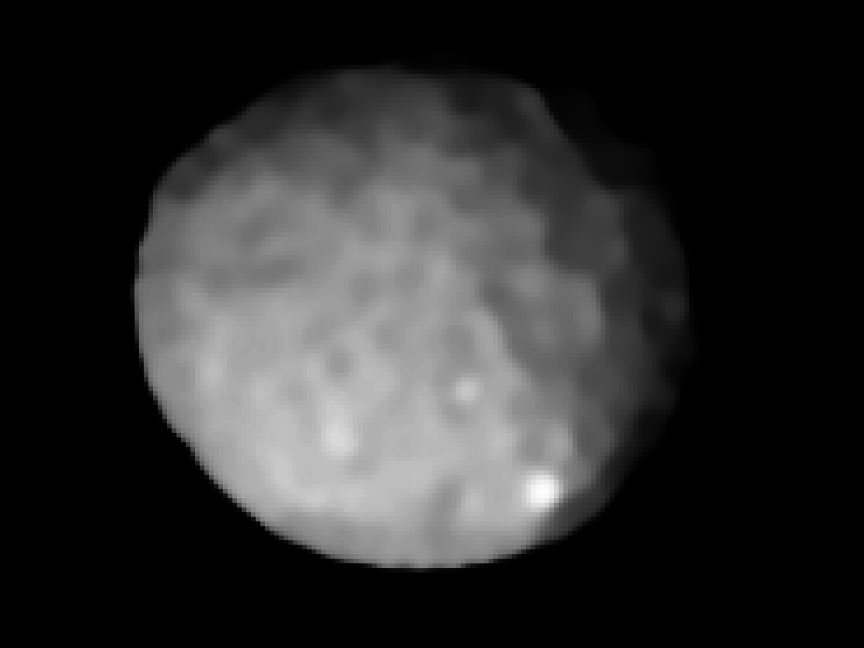
ESO / Vernazza et all.
Free samples of Vesta have been delivered to Earth over the eons as meteorites belonging to the HED clan, a relatively uncommon type of achondrite whose members include the Howardites, eucrites, and diogenites. Pallas more closely resembles Ceres and the carbonaceous chondrites in our meteor collections. Since primitive carbonaceous meteorites look like lumps of coal, it's not surprising the asteroid appears so dark. Pallas is also related to the near-Earth asteroid 3200 Phaethon, the source of the annual Geminid meteor shower and a member of the Pallas impact family of asteroids. Every December, Pallas-related material flashes across our night skies!
We may learn much more about Pallas soon. NASA is considering funding a small-satellite to Pallas called Athena. It would piggyback on the Psyche Mission to the metal-rich asteroid 16 Psyche. After launch in August 2022, the two spacecraft would part ways, with Athena flying by Mars for a gravity assist to Pallas. Sometime in 2024 the mini-fridge-sized probe would fly by Pallas for a quick study and photographic tour.
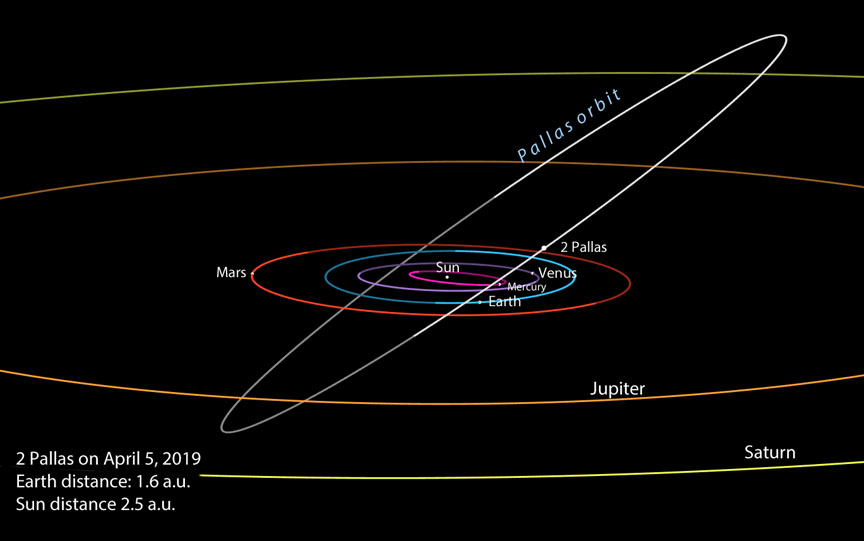
JPL Horizons with additions by the author
You can beat NASA there with your little telescope on the next clear night. On the date of opposition, this stellar masquerader will be easy to find just 1.2° south of the 2.7-magnitude star Eta (η) Boötis. On the 10th, it will pass within just a few arcminutes north of the star, making for a wonderful (and easy) observing opportunity.
Pallas travels northwest in retrograde, crossing the border into Coma Berenices in early May as it slowly fades. Come early June, it's still magnitude 9.0 and visible in a 2-inch telescope. In case you're wondering what an asteroid is doing way up north by Arcturus, Pallas has a steeply inclined orbit (34.8°) and strays far from the well-trodden ecliptic.
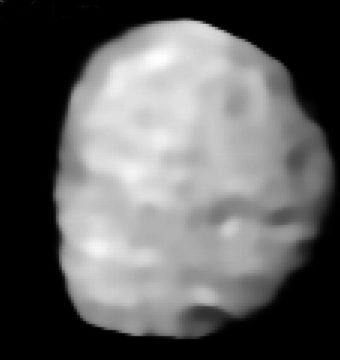
ESO / Vernazza et all.
Our second asteroid, 7 Iris, was discovered in August 1847 by English astronomer J.R. Hind, who went on to discover nine more. Iris is one of the larger and brighter asteroids with a diameter of 200 km and reflectivity of 19%, making it the fourth brightest in the main belt. Under favorable circumstances, when it comes to opposition at perihelion, Iris can shine as bright as magnitude 6.7.
This time it will manage magnitude 9.4 at opposition on April 5th. While below binocular limit for many, it remains an easy find in a small telescope. Iris travels northwest from northern Corvus into Virgo in the coming weeks while slowly fading to magnitude 10 by early June. You can watch its stately march even from a light polluted location.
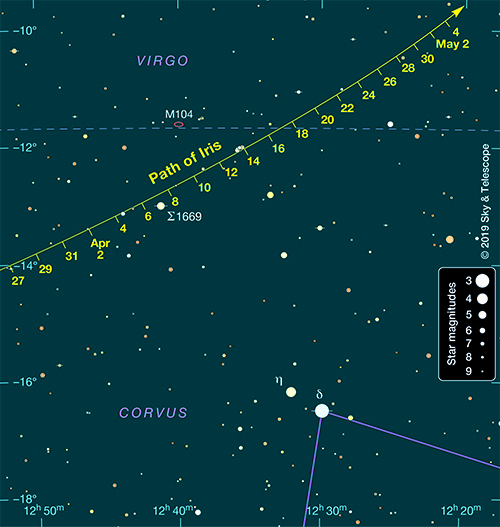
Asteroids are fun to follow for what they are, but they also take us to corners of the sky we might not normally visit. Iris slides just under 1° (55 arcminutes) south of the bright Sombrero Galaxy (M104) for several evenings centered on April 10th, the night of its closest approach. Sharing the same low-power field of view, you can watch the tiny space fragment slowly approach and pass the galactic behemoth.
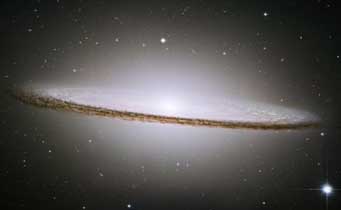
NASA / ESA
Like Pallas, Iris orbits within the main belt but has a much "flatter" orbit, inclined just 5.5° to the ecliptic. But what it lacks in orbital extremity it makes for with an axial tilt of 85°. Similar to Uranus, Iris experiences seasonal extremes with its hemispheres alternately baked in continuous sunshine or chilled during the long night. Spectroscopic examination of the surface reveals that Iris is a stony asteroid containing iron-nickel and silicate minerals similar to the L and LL chondrite meteorites that fall to Earth.
You can use the individual color charts above to track each asteroid or this dual black-and-white map that features both. I wish you clear skies as you embark your own personal asteroid mission.
 21
21








Comments
Rod
March 27, 2019 at 1:10 pm
Bob, challenging targets here for small telescope users 🙂 I checked Pallas for 06-April close to Eta Bootis star. I may give it a try using my 90-mm refractor with Telrad. However, I checked ahead in my software and see other faint stars nearby Pallas in Bootes near 2200 EDT but Pallas looks the brighter of them. Perhaps an easy target near 7.9 apparent magnitude but may be tougher to pick out unless you observe over several nights and see motion near Eta Bootis star. I could keep Eta Bootis in the field with Pallas at 25x and 31x views, about 1.6 to 1.8-degree true field.
You must be logged in to post a comment.
Bob KingPost Author
March 27, 2019 at 2:15 pm
Hi Rod,
A 90mm scope is perfect for Pallas. There are indeed several 7-8 mag. stars near Pallas around April 6, but they're all plotted nicely on the map and easy to distinguish from Pallas by position. On the night of the 10th, the only bright object so close to Eta Boo will be Pallas, making it even easier to identify. Depending on your location, the two will just a few arc minutes apart. No other mag. 8 stars nearby. Good luck — my gut tells me you'll find it no problem.
You must be logged in to post a comment.
Anthony Barreiro
March 27, 2019 at 7:56 pm
Rod, sketching is a great way to confirm an asteroid sighting, and this is such an easy sketch that even I can do it.
Using a wide field eyepiece, center on what you think is the asteroid. Trace a circle for your field of view. Put dots for the stars and suspected asteroid, bigger dots for brighter objects. Label the dot you think is the asteroid. Compare to your finder chart and/or star atlas for an initial confirmation.
Then come back to the same field of view the next night, or two or three nights later, put the brightest stars in roughly the same places in the field, and do another sketch. The point that moves from one sketch to the next is the asteroid.
This is how Olbers, Hind, and their buddies found asteroids 200 years ago.
You must be logged in to post a comment.
Rod
March 28, 2019 at 12:20 pm
Anthony, thanks for this info on sketching. I will try it, perhaps I can do this too 🙂 If I observe Pallas (weather permitting), it will be the first asteroid entry in my stargazing log and I like that idea.
You must be logged in to post a comment.
Anthony Barreiro
March 28, 2019 at 12:53 pm
If you log Pallas, Vesta at opposition will be a piece of cake.
You must be logged in to post a comment.
Bob KingPost Author
March 29, 2019 at 10:22 am
Great idea, Anthony. Sketching always make for a closer connection and greater familiarity with what's seen in the telescope.
You must be logged in to post a comment.
Joe Stieber
March 27, 2019 at 3:49 pm
I’ve already seen and taken snapshots of these two asteroids this year.
From the relatively dark New Jersey Pines, I saw (7) Iris on 30-Jan-2019 with my 85 mm spotting scope when it was at magnitude 10.5, 18 arc minutes from C/2018 Y1 (Iwamoto), and about 5 degrees from Spica.
I took a snapshot of (2) Pallas, magnitude 8.0, on 12-March-2019 from the Pines, while testing a new camera. I was actually able to see it on the live view screen, so I never put a scope or binoculars on it. This past Saturday night, 23-March-2019, I saw it from the Pines in my 12.5-inch reflector, and showed it to some other folks. It’s sad that few other amateur astronomers seem interested in tracking down even the brighter asteroids. Like comets, I’m always fascinated by their movement.
The snapshots are on my web page, which is linked from my name above this post. Scroll down to see them.
You must be logged in to post a comment.
Bob KingPost Author
March 29, 2019 at 10:21 am
Thanks, Joe for sharing for sharing your asteroid pix!
You must be logged in to post a comment.
Joe Stieber
March 29, 2019 at 11:47 pm
You’re welcome Bob, and I added a link to this fine article. I’m hoping the forecast holds true and it’s clear Sunday night, March 31/April 1, 2019. I’ll try for four asteroids overnight with my 15x56 binoculars and/or my 85 mm spotting scope. They are (3) Juno, (7) Iris, (2) Pallas and (1) Ceres (from west to east).
You must be logged in to post a comment.
Joe Stieber
April 2, 2019 at 12:15 am
Wel, I managed to see Juno, Pallas and Ceres overnight March 31/April 1, 2019. Juno was seen from my suburban backyard at 9:25 pm EDT with an 85 mm spotting scope at 60x. Pallas and Ceres were seen from the dark NJ Pines shortly after 3 am EDT with 15x56 binoculars. I thought I saw Iris with the binoculars, but in looking at my snapshots later, I’m not sure. I should have double checked this fainter asteroid with the spotting scope, but I didn’t set it up. I did get snapshots of Iris, Pallas and Ceres from the Pines. They’re on my web page linked from my name above this post.
You must be logged in to post a comment.
Bob KingPost Author
April 3, 2019 at 9:01 am
Good to hear it, Joe. Thanks for sharing your photos with me and the readers.
You must be logged in to post a comment.
Scopion
March 29, 2019 at 8:08 pm
We will be looking for it tonight at the Community Observatory. Been a while since we had some clear skies. We are expecting a big crowd.
Tom Hayhurst
You must be logged in to post a comment.
Bob KingPost Author
March 29, 2019 at 8:10 pm
Happy to hear it, Scopion! I hope all enjoy the sight.
You must be logged in to post a comment.
Anthony Barreiro
March 30, 2019 at 10:43 pm
I saw Pallas for the first time during her current apparition at 0520 PDT this morning, through mounted 15x70 binoculars, using a printout of the finder chart above. Pallas and the 7th magnitude star right on the path south of the tick mark for 31 March looked like a very wide, evenly matched double star. Pallas was west of the star. Later I looked at Sky Safari. The star is 7.1 magnitude HD122676 and they were separated by 108 arcseconds.
I'm hoping for more clear weather so I can see Pallas move. That's the fun part.
You must be logged in to post a comment.
Anthony Barreiro
March 31, 2019 at 1:48 pm
By 0515 this morning Pallas had moved about a quarter degree north from HD122676. The greater separation between them allowed me to see that the asteroid is dimmer than the star.
You must be logged in to post a comment.
Rod
April 1, 2019 at 7:53 pm
Anthony, glad to hear you are able to see Pallas. It was lovely early this morning but now clouds moving in and rain 🙂 Perhaps Wednesday for me because more clouds and rain look to be on the way here where I am at in Maryland later this week. Please get some good asteroid observing in for me 🙂 I will not log in my stargazing log 🙂 I may have to wait a bit now.
You must be logged in to post a comment.
Rod
April 3, 2019 at 11:47 pm
Bob and Anthony, success 🙂 I was out tonight until 2315 EDT or 11:15 PM. I used my trusty 90-mm refractor with Telrad, 32-mm plossl at 31x and close to 1.6-degree true FoV. From my log "I viewed 2 Pallas or Pallas asteroid tonight using 32-mm plossl. The position according to Starry Night was in a 3 star field of HIP68517 and two other stars, HIP68209 and HIP68234. These 3 stars are +7.37 to + 7.56 apparent magnitudes. This made identification easier and Starry Night shows Pallas at mv +7.16 but closer to +7.8 likely from appearance. Sky & Telescope indicates mv +7.9. The angular separation between HIP68517 and HIP68209 is 1 deg 03'. HIP68209 and HIP68234 angular separation 12'. Pallas was in this three star field so easy to identify. The April Sky & Telescope Celestial Calendar shows similar position. Stellarium 0.19.0 is updated for 2 Pallas and shows similar position with these three stars in Bootes. Stellarium shows mv +7.9 for Pallas. I did not think I would see this asteroid as it approaches opposition on 06-April-19. I did and this was fun."
You must be logged in to post a comment.
Anthony Barreiro
April 4, 2019 at 5:34 pm
Congratulations Rod! Finding and following asteroids is a lot of fun. Making a positive identification is enough of a challenge to give a sense of accomplishment. But, at least for the brighter asteroids, if the sky is clear and you've got a good finder chart, it's doable, even through light pollution.
Now if you want a tougher challenge, look for Iris. Magnitude 9.4 might not sound that much dimmer than 7.9, but the magnitude scale is logarithmic. Pallas is four times as bright as Iris!
You must be logged in to post a comment.
TomR
April 8, 2019 at 11:06 am
Dear Bob,
thank you for your article and the finder chart!
I could find Pallas in my 7x42 binoculars and watch her motion during several days. (My first asteroid)! :-)
Do you think it is possible to resolve a tiny disk in a big amateur’s telescope?
Kind regards, Thomas, Austria
You must be logged in to post a comment.
Kerbal9
April 11, 2019 at 1:43 am
Thank you!
I've look at these asteroids first time, this article was very helpful.
-- Andrey, Russia, 57 deg lat
You must be logged in to post a comment.
Rod
April 11, 2019 at 11:00 am
Last night I enjoyed more views of 2 Pallas asteroid, 2100-2145 EDT in Maryland using my 90-mm refractor. Since 03-April-19, I tracked the asteroid Pallas moving close to a NW path through Bootes, some 2.5 degrees or so logged in my stargazing database. Pallas asteroid is now past Muphrid or Eta Bootis star. Last night Pallas was about 3 arcminute from Muphrid or Eta Bootis near 2:00 position and TYC1470-646-1 star < 2 arcminute from Muphrid near 5:00 position. North is up, mirror reverse view. These three formed a tight group at 71x and 1-degree true FoV in the eyepiece so very easy to see and identify. The asteroid Pallas came to opposition on 06-April-19, is a main belt asteroid between Mars and Jupiter with a 4.62 year orbital period around the Sun. Last night Pallas was a bit more than 1.61 astronomical units from Earth while the star Muphrid about 37 light years distance and TYC1470-646-1 star about 2810 LY based upon stellar parallax and apparent magnitude (faint, mv +9.8), spectral class K2 III in SIMBAD portal. While viewing this trio in Bootes last night, Earth's rotation obvious. I made periodic adjustments to altitude and azimuth controls to keep Muphrid, 2 Pallas, and TYC1470-646-1 centered in eyepiece FoV. I enjoyed viewing, tracking, and logging 2 Pallas, my first asteroid observation.
You must be logged in to post a comment.
You must be logged in to post a comment.